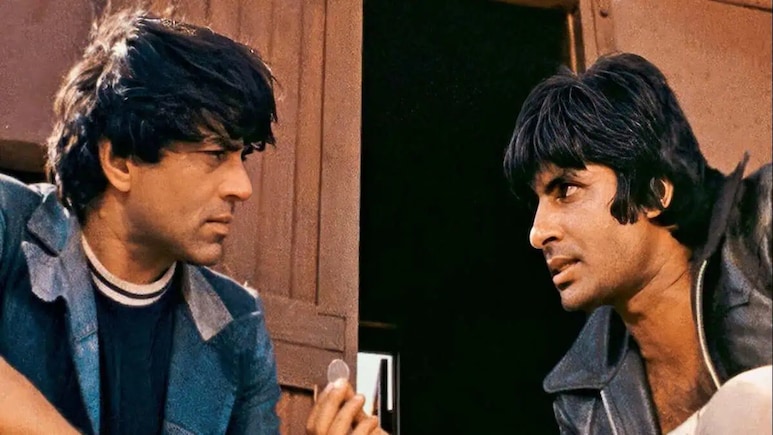
Long before its release on Independence Day in 1975, the cast and crew of Sholay had already enthralled the residents of many Navi Mumbai villages that drew filmmakers for their bucolic settings.
Half a century later, residents of the villages along the Panvel-Uran road still cherish the memories of the shooting of the film, which went on to become a cult classic, even though urbanisation has changed the face of those ‘lights, camera, action' sites.
The Agris and Kolis, the dominant communities of the region who then depended on paddy farming and fishing for livelihood, would throng the sets every single day of the shooting, which began in the area around 1972.
“Dharmendra, who played Veeru, at times mingled with the locals and enjoyed ‘jawla sukat' (dry fish) and ‘tandul bhakri' (rice flour flatbread) shared by the Agri people. Dharmendra would exchange his biryani or the meal specially cooked for him with the locals,” recalled Sanjay Shelar (62).
Not just the superstar, the crew members also had their fair share of exchanges with the locals. They would pass on their drinks to the villagers, who got them home-made brew, he said.
Many scenes of the Ramesh Sippy masterpiece were shot along the Panvel-Uran road, said Shelar. Most of Sholay was, however, filmed in a rocky hill range, about 50 km from Bengaluru.
The film crew, including actors Dharmendra, Sanjeev Kumar, Amitabh Bachchan, Jaya Bachchan and Hema Malini, would stay put at Pravin hotel in Old Panvel. Space was created behind the hotel to keep the horses, Shelar said.
The scene in which ‘Basanti' (Hema Malini) picks up ‘Jai' (Amitabh Bachchan) and ‘Veeru' from the railway station to take them to Ramgad was shot near Panvel railway station, he said.
Hundreds of youths and children would skip work and school to watch Team Sholay in action, with the ‘Dream Girl' (Hema Malini) drawing the maximum attention, Shelar said, recalling that he and his friends would cycle to the shooting sites.
The scene in which Veeru aims at mangoes with a pistol was filmed in the mango grove of Chinchpada. In this scene, Veeru tries to flirt with Basanti under the guise of giving her shooting lessons, prompting Jai, lazing under a tree, to quip “Lag gaya nishana.” A vehicle garage has replaced the mango grove today.
The iconic sequence, showing dacoits of Gabbar Singh (Amjad Khan) attempting to rob a moving train, chasing it on horseback, opening fire, and fighting with Jai and Veeru, was filmed entirely on and along the Panvel-Uran railway line near ‘Bambavi Pada', commonly known as Bombay Pada, Shelar said.
The exaggerated narration of Soorma Bhopali (Jagdeep) in a sawmill of how he supposedly fought off a group of dacoits was also shot in this area, said Shelar. “The sawmill is operational even today,” he added.
Prabhakar Mundkar, a resident of Bambavi Pada, said he used to sell watermelons to the villagers, who would crowd around the film sets. The high-voltage scene showing the train smashing through a pile of logs on the tracks was shot in their village, he recalled.
That old track is still active today, allowing goods trains to transport containers.
Janardhan Nama Patil, an 82-year-old resident of Bambavi village, vividly remembers the shooting of Sholay in the region. He recalled the filming of the sequence in which horses chase a train, Veeru fights dacoits, and burning coal is hurled onto a wagon, triggering a fire.
Naresh Gaikar (56), who spent his childhood in Uran, said that the producers had created a village near Bambavi Pada, where the shootings used to take place.
“Towards the movie's climax, the Gabbar gang abducts Basanti. A small boy shows Veeru the path taken by the dacoits. That boy was from Owala village in the vicinity,” said Chandrakant Patil, another resident of Bambavi village.
The last exchange of fire between Jai and the dacoits on a small wooden bridge was created in this area, he said.
Though the locals continue to cling to those memories, Patil rues that the idyllic surroundings of the 70s are all gone.
“CIDCO (City and Industrial Development Corporation) acquired our land and started various projects, due to which the mountains, hills, gorges, and water bodies have vanished. We now have fond memories of the past,” he said.
“We can proudly say that our villages were so beautiful that producers and directors used to choose them as shooting locations,” Patil said.
Not just Sholay, several villages along the Panvel-Uran road also featured in films like Nastik, Yadon Ki Barat and Papi, but the impact left by Sholay on the generations is something else, he said.
“The fact that one visits the shooting location even after 50 years is the real success of Sholay,” he said beamingly, adding that the film is a staple topic of discussion in their villages.
(Except for the headline, this story has not been edited by NDTV staff and is published from a syndicated feed.)

